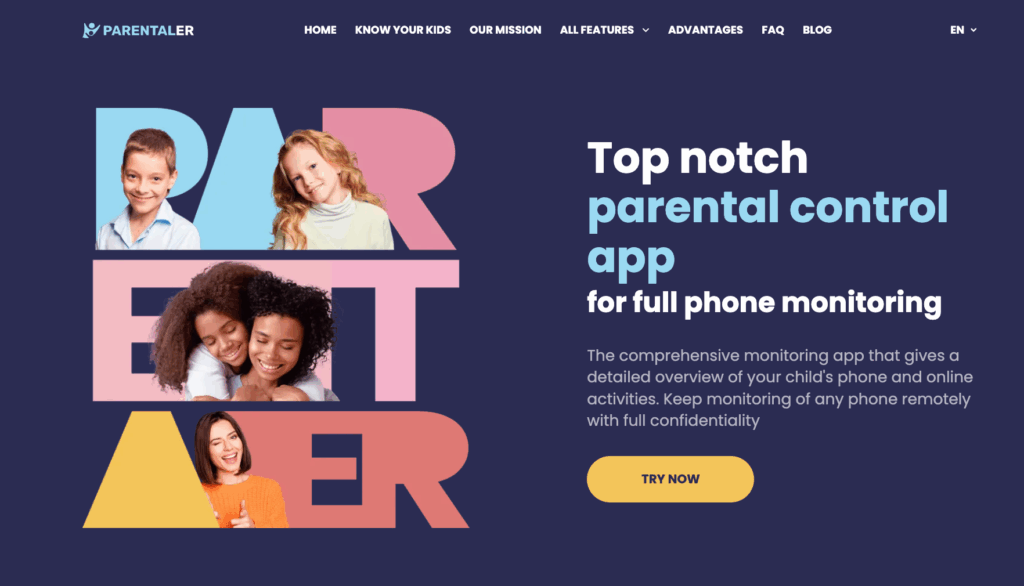

Astăzi, părinții trebuie să se asigure că copiii lor sunt în siguranță online. Internetul este vast și nu este întotdeauna reglementat. Este important să existe un loc sigur în care copiii să navigheze.
A browser web prietenos cu copiii îi ține pe copii departe de conținutul rău și de agresori. De asemenea, îi protejează de pericolele online. În acest fel, părinții se pot relaxa știind că copiii lor sunt în siguranță online.
De ce browserele sigure sunt esențiale pentru copii
Astăzi, un control parental browser este o necesitate. Internetul este plin de lucruri bune pentru copii, cum ar fi să învețe și să își facă prieteni. Dar are și pericole, cum ar fi site-urile web proaste, hărțuirea și prădătorii.
A browser sigur pentru copii îi ține departe de rele. Acesta le permite părinților să blocheze site-urile dăunătoare, să urmărească ce fac copiii online și să controleze cât timp petrec aceștia pe ecrane.
Păstrarea copiilor în siguranță online este foarte importantă. Iată de ce browserele sigure sunt esențiale:
- Ei blochează conținutul rău: Browserele sigure țin copiii departe de site-urile pentru adulți și de conținutul violent.
- Îi lasă pe părinți să privească: Părinții pot vedea ce fac copiii lor online și pot depista problemele din timp.
- Ei luptă împotriva cyberbullying-ului: Urmărind interacțiunile, părinții pot opri sau aborda hărțuirea.
- Ele pot fi configurate corect: Multe browsere sigure permit părinților să ajusteze setările în funcție de vârsta și nivelul de maturitate al copilului lor.
Alegerea unui browser cu controale parentale îi face pe copii mai siguri pe internet. În acest fel, copiii se pot bucura de internet în siguranță, fără a se confrunta cu prea multe pericole.
Principalele caracteristici ale unui browser sigur
Pentru a le oferi copiilor o internet securizat, cunoașterea caracteristicilor cheie ale unui browser sigur este esențială. Un browser creat pentru copii trebuie să aibă părți importante pentru a-i menține în siguranță online.
Moduri de navigare sigure pentru copii sunt o necesitate. Aceste moduri blochează conținutul rău și permit copiilor să viziteze numai site-uri sigure. De asemenea, filtrarea conținutului este esențială. Aceasta îi împiedică pe copii să vadă conținut dăunător sau rău.

Puternic măsuri de securitate sunt, de asemenea, vitale. Acestea protejează împotriva malware-ului și a phishing-ului, pericole majore pentru copiii online. Criptare bruiază datele pentru a proteja informațiile copiilor de hackeri.
Un browser sigur ar trebui să utilizeze motoare de căutare sigure de asemenea. Aceste motoare de căutare elimină conținutul rău din rezultatele căutării. În plus, instrumente de monitorizare îi ajută pe părinți să supravegheze activitățile online ale copiilor lor. Aceste instrumente le permit părinților să știe dacă copiii lor sunt în pericol online.
Pe scurt, un browser sigur pentru copii ar trebui să aibă:
- Navigare în siguranță pentru copii moduri
- Filtrarea conținutului
- Măsuri robuste de securitate împotriva programelor malware și phishing
- Criptare pentru a proteja datele personale
- Motoare de căutare sigure
- Instrumente de monitorizare pentru supravegherea parentală
Cu aceste caracteristici, un browser sigur îi poate ajuta pe copii să exploreze internetul în siguranță.
Cel mai bun browser sigur pentru copii
Găsirea browserului sigur potrivit pentru copii poate fi o provocare, deoarece părinții doresc o filtrare puternică fără a face experiența de navigare frustrantă. Iată recenzii ale unora dintre cele mai bune browsere sigure pentru copii în 2025.
Qustodio
Qustodio este mai mult decât un simplu browser - este o suită completă de control parental care funcționează pe toate dispozitivele și sistemele de operare. Filtrarea web este precisă și eficientă, blocând site-urile inadecvate fără a restricționa excesiv conținutul educațional. Tabloul de bord este clar, oferind părinților rapoarte de activitate, limite de timp și blocarea aplicațiilor. Versiunea gratuită este limitată la un singur dispozitiv, astfel încât familiile cu mai multe gadget-uri vor avea nevoie de planul premium.
Kaspersky Safe Kids
Kaspersky Safe Kids oferă unul dintre cele mai complete sisteme de filtrare, cu AI în timp real care clasifică conținutul în 14 niveluri diferite de siguranță. Acesta funcționează bine pentru copiii de diferite vârste, datorită restricțiilor personalizabile. Monitorizarea căutărilor pe YouTube este deosebit de utilă pentru blocarea videoclipurilor nesigure. Cu toate acestea, versiunii iOS îi lipsesc unele caracteristici în comparație cu Android, ceea ce poate fi un dezavantaj pentru gospodăriile cu mulți utilizatori Apple.
Mobicip
Mobicip se remarcă prin filtrarea dinamică în timp real și prin capacitatea de a bloca videoclipurile nepotrivite chiar și atunci când acestea sunt încorporate în alte site-uri. Aplicația acceptă, de asemenea, programarea timpului petrecut pe ecran și gestionarea aplicațiilor. Părinții pot bloca de la distanță dispozitivele sau pot acorda timp suplimentar de navigare. Interfața este rafinată, iar configurarea este simplă, deși unele setări avansate sunt ascunse în spatele meniurilor, ceea ce le face mai puțin intuitive pentru utilizatorii noi.
KidZui
Conceput pentru copiii mai mici, KidZui utilizează o abordare de tip listă albă, permițând numai site-uri web aprobate. Browserul are un design jucăuș, colorat, care se adresează copiilor sub 10 ani. Deși asigură siguranță maximă, copiii mai mari îl pot găsi prea restrictiv, iar timpii de încărcare pot fi un pic lenți în comparație cu browserele moderne.
Kiddle
Kiddle este mai degrabă un motor de căutare decât un browser complet, dar oferă o experiență de navigare sigură prin utilizarea Google SafeSearch cu rezultate adaptate copiilor. Miniaturile mari și limbajul simplu îl fac atrăgător pentru copiii care învață să citească. Este ideal pentru o utilizare supravegheată sau pentru adăugarea unui nivel suplimentar de siguranță pe dispozitive partajate, dar îi lipsesc controlul timpului și rapoartele de utilizare.
Gestionarea conținutului și Curation

Pentru ca copiii să fie în siguranță online, trebuie să gestionați ceea ce văd. Părinții pot bloca conținutul rău și pot găsi site-uri web sigure pentru copiii lor. În acest fel, copiii pot învăța și se pot juca online fără să vadă lucruri pe care nu ar trebui să le vadă.
Principalele caracteristici ale gestionării conținutului
- Filtrarea conținutului pentru a bloca accesul la teme dăunătoare sau mature
- Liste curate de site-uri și resurse prietenoase pentru copii
- Setări personalizabile pentru a se adapta la vârsta și nivelul de maturitate al unui copil
O bună gestionare a conținutului este esențială pentru a menține copiii în siguranță online. Cu ajutorul acestor instrumente, părinții se pot asigura că copiii lor au un loc sigur pentru a explora și învăța. Acest lucru îi ține departe de conținutul rău.
Unele browsere oferă și funcții suplimentare:
- Monitorizarea istoricului de navigare pentru a urmări activitățile online ale unui copil
- Alerte pentru încercări de conținut suspect sau inadecvat
- Recomandări personalizate pentru conținut pentru copii
Folosind aceste instrumente, părinții se pot relaxa știind că copiii lor sunt în siguranță online. Ei pot fi siguri că copiii lor navighează responsabil.
Gestionarea timpului și a utilizării ecranului

Copiii petrec tot mai mult timp online și este esențial să le gestionăm timpul petrecut pe ecran pentru bunăstarea lor. A browser sigur pentru copii ajută foarte mult. Acesta oferă părinților instrumente pentru a supraveghea cât timp petrec copiii lor online.
Stabilirea limitelor și urmărirea utilizării îi ajută pe părinți. În acest fel, copiii nu petrec prea mult timp holbați la ecrane. Viața lor rămâne echilibrată, cu timp pentru activitate fizică, socializare și învățare.
Iată câteva caracteristici importante pe care trebuie să le căutați la un browser sigur pentru copii:
- Limitele de timp: Setați limite de timp zilnice sau săptămânale pentru utilizarea internetului.
- Monitorizarea activității: Urmăriți site-urile web vizitate și aplicațiile utilizate de copii.
- Setări personalizabile: Permite părinților să ajusteze setările în funcție de vârsta și nevoile copilului lor.
- Alerte și notificări: Primiți alerte atunci când copiii încearcă să acceseze conținut restricționat sau depășesc limitele de timp.
Folosind aceste caracteristici, părinții pot face din internet un loc mai sigur pentru copiii lor. Este vorba despre găsirea echilibrului corect. Să se asigure că timpul petrecut în fața ecranului nu dăunează vieții copiilor lor.
Controale parentale și instrumente de monitorizare
Controalele parentale și instrumentele de monitorizare sunt esențiale pentru a menține copiii în siguranță online. Acestea permit părinților să urmărească ce fac copiii lor online, să blocheze conținutul rău și să limiteze timpul petrecut pe ecran. Acest lucru contribuie la transformarea internetului într-un loc mai sigur pentru ei.
Utilizarea unui control parental browser oferă părinților mai mult control asupra lumii online a copiilor lor. Aceștia pot vedea ce site-uri web vizitează copiii lor, le pot verifica istoricul căutărilor și pot primi alerte pentru orice lucru suspect.
Cea mai bună alegere - Parentaler.com
Parentaler.com este o alegere de top pentru controlul parental. Acesta are o mulțime de instrumente și caracteristici care îi ajută pe părinți să își protejeze copiii online. Cu Parentaler.com, părinții obțin multe beneficii, inclusiv:
- Monitorizarea în timp real a activităților online
- Filtre personalizabile pentru a bloca conținutul inadecvat
- Alerte pentru comportamente online suspecte
- Rapoarte detaliate privind timpul petrecut pe ecran și obiceiurile online
Aceste controale avansate îi ajută pe părinți să reducă riscurile activităților online ale copiilor lor. Ele asigură un spațiu online mai sigur și mai controlat pentru copiii lor.
Sfaturi pentru a-i învăța pe copii practici online sigure
Pentru ca copiii să fie în siguranță online, părinții trebuie să îi învețe despre siguranța online. Este important să îi învățați pe copii cum să evite pericolele și să se comporte responsabil online. Acest lucru este esențial pentru siguranță online pentru copii.
Începeți prin a vorbi deschis despre pericolele online, cum ar fi hărțuirea informatică și phishing-ul. Explicați-le cum să identifice e-mailurile suspecte și de ce să nu împărtășească informații personale online. Acest lucru îi ajută pe copii să înțeleagă riscurile.
Iată mai multe sfaturi pentru siguranța online:
- Învățați-i pe copii să folosească parole puternice, unice și să le păstreze secrete.
- Arătați-le cum să utilizeze setările de confidențialitate pe rețelele sociale pentru a controla cine le vede informațiile.
- Vorbiți despre pericolele partajării online a fotografiilor personale sau compromițătoare.
- Fiți cu ochii pe activitățile lor online și discutați despre experiențele lor.
Părinții îi pot ajuta pe copii să fie în siguranță pe internet prin învățarea unor obiceiuri online bune și prin monitorizare. De asemenea, este esențial ca părinții să rămână informați cu privire la noile amenințări și măsuri de siguranță. În acest fel, ei își pot proteja mai bine copiii.
Păstrarea siguranței online a copiilor este un efort continuu. Este nevoie de răbdare, atenție și educație. Colaborând cu copiii și folosind instrumente precum controlul parental, părinții pot îmbunătăți considerabil siguranța online a copiilor lor.
Concluzie
Păstrarea siguranței online a copiilor este o preocupare majoră pentru părinți. Un browser sigur pentru copii este esențial pentru atingerea acestui obiectiv. Acesta le permite să exploreze și să învețe în siguranță.
Este important să alegeți un browser bun, cu securitate și controale puternice. Acest lucru ajută la menținerea copiilor departe de pericolele online. De asemenea, este vital să gestionați conținutul și să monitorizați timpul petrecut în fața ecranului pentru a-i învăța să folosească internetul cu înțelepciune.
Urmând sfaturile din acest articol, părinții își pot ajuta copiii să rămână în siguranță pe internet. Cu instrumentele potrivite și câteva îndrumări, copiii se pot bucura de avantajele internetului fără riscuri.
Păstrarea siguranței pe internet pentru copii este un efort continuu. Este nevoie de atenție, răbdare și instrumentele potrivite. Rămânând informați și folosind instrumentele potrivite, părinții pot asigura o experiență online sigură pentru copiii lor.




